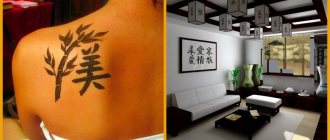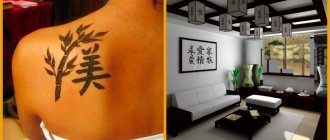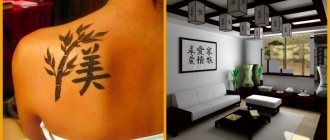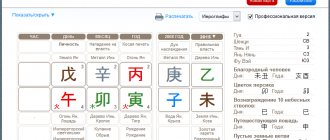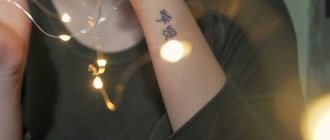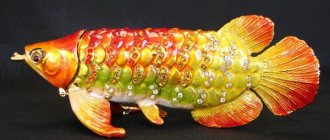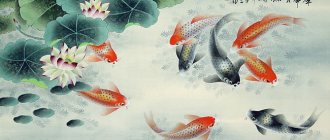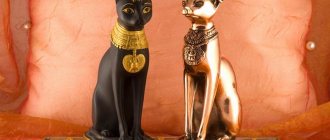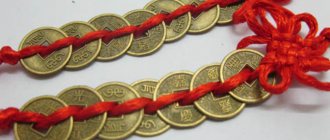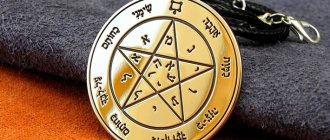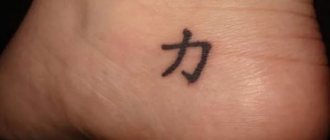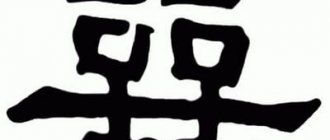Chinese and Japanese characters always carry a semantic load, reflecting individual meaning and purpose. Residents of these Asian countries endow each such symbol with special energy in order to get the desired result and fulfill their own dreams.
An important character in Japanese and Chinese writing is “strength,” which is of great importance to the people of China and Japan. These symbols are considered favorable and happy in both countries, but this sign must be used carefully so as not to upset the energy balance.
Chinese character strength
It is considered a talisman that can fill a person with wisdom, vitality and strength. It also improves physical and mental well-being, gives a feeling of power and unlimited possibilities, and self-confidence. Thanks to the close location of the hieroglyph “strength,” a person’s ambitions and desires will constantly grow, new ideas will be born, and creativity will skyrocket.
This hieroglyph has a special influence on athletes, creative individuals, and businessmen, charging them with the energy of victory. Always helps when concluding deals, at meetings, creative competitions, and competitions.
The hieroglyph must be placed so that it is always with the person and in sight. It is best to tell it in the zones of fame (south), wealth (southeast) and career (north).
Used in meanings such as:
- Energy or force energy 能源动力.
- To influence something, to use force 他施加力到它.
- Ability, including the ability for music 在音乐的能力.
- Domestic violence 家庭暴力.
- Study hard 努力学习.
The pictogram is suitable for residents of large cities who lead an active lifestyle and are tired of city noise. They constantly need to restore energy in order to fill their body with health and strength, help them spread their wings, grow in their careers, stabilize life processes, build and implement plans.
You should not combine it with other hieroglyphs, so as not to harm yourself, your loved ones, desires and ideas.
Description
Consists of one hieroglyph, which consists of two small lines. This hieroglyph is located in the dictionary under number 19.
It is denoted by 力 and can be used as part of various phrases, in complex hieroglyphs and can act as a separate grapheme. Placed in different parts of complex structures.
Writing rules
The character 力 is a pictogram that depicts a person bending down. This is how he lifts an object using muscle power. The vertical line 丿 is the meaning of a hand, a hook that is curved down like a brush.
Sometimes the pictogram is interpreted as a plow, i.e., a heavy tool that requires physical strength to use. Agriculture has always played and continues to play an important role in the life of the Chinese, which is why they invented a special sign to represent the plow and physical strength.
How to read
It must be pronounced in tone No. 4. It is read as “li.”
Which hieroglyphs to choose for a tattoo?
Thanks to the art of calligraphy, any name can be written in the form of an oriental sign. If you choose Chinese characters for your tattoo, names are a good idea. However, be careful and entrust the translation of your name only to a trusted professional who understands all the intricacies of the Chinese language. Otherwise, there is a risk of having something tattooed on your body that does not have an adequate translation at all.
Symbols denoting worldview and lifestyle are also in demand in tattoo parlors:
- Eternity.
- Karma.
- Eternal wandering.
- Emptiness.
These are mystical signs that leave an imprint on a person’s life. They symbolize the path of man, his development.
For those wishing to choose a less mysterious option, hieroglyphs representing animals are ideal.
Moreover, you can choose both real and mythical characters:
- The horse is a symbol of loyalty, hard work, grace and optimism.
- The snake is the personification of femininity, beauty and eternal renewal.
- Green dragon and white tiger - serve as protection from enemies, fill with energy and contribute to success in business and material well-being.
- The rat is a sign of wealth and prosperity.
- The dragon is a patron in family and financial affairs, symbolizing strength and power.
A tattoo requires an idea for its implementation, and not every person has a specific idea about their future tattoo. And the selection of a sketch of a Japanese hieroglyph must be done even more carefully, since this is not an arbitrary combination of lines, but a symbol with a great semantic load.
Japanese character strength
According to the accepted version, hieroglyphs were brought to Japan by Buddhist monks. Chinese writing was successfully assimilated on the islands, since the Japanese did not have their own writing at that time. Then their own Japanese characters appeared, based on Chinese pictograms. The sign for “strength” in Chinese and Japanese is identical, only the spelling differs.
Examples of usage in the literal sense:
- Physical strength - 体力 (kanji - tairyoku).
- Rickshaw – 人力車 (jinrikishya).
- strength, power – 強力 (kyou:ryoku).
In other meanings:
- Effort or effort – 努力 (doryoku).
- Ability and skill – 能力 (no:ryoku).
- Cooperation – 協力 (kyou:ryoku).
Description
The first part denotes spirit, mood and disposition, soul. The second part is interpreted as power, strength, both physical and spiritual, moral. Therefore, the pictogram is also translated as “strength of spirit.”
Writing rules
The pictogram 刀 (chikara) is written with two dashes, which can be found in other Japanese words. The kanji for "strength" can also be written as ryoku, riki.
Features of tattooing in the form of hieroglyphs
Abundance. Chinese tattoo hieroglyphs, which help to attract something or protect from something, are extremely popular. And the hieroglyph meaning abundance breaks all records. Even among the Chinese, wealth is one of the main wishes for the holidays.
The hieroglyph consists of such parts as “house”, “mouth” and “field”. That is, shelter, food and a source of food. Basic needs are what the Chinese understand as abundance.
The hieroglyph that illustrates wealth is perfect for a
Buddha tattoo. An extremely strong person in Chinese culture and therefore a powerful talisman. His interpretation is curious - Buddha consists of the element “man” and the particle “not”. That is, divine origin is emphasized. It is believed that the talisman helps to improve oneself and find enlightenment.
We invite you to familiarize yourself with: Meditations “Opening the flow of love” by Klaus Joule: technique of sending love and other practices from the author || Sending love to Klaus Joel
Hieroglyph tattoo in the form of Buddha
Longevity. One of the most important wishes of the Chinese. It is interesting that this hieroglyph comes from the word “field”. Then the "elderly" icon was added. The eastern people were sure that doing manual labor and eating natural food was the key to long life.
Talisman tattoo meaning longevity
Luck. This hieroglyph consists of the symbols "sage" and "speech". In other words, luck is not just fatalism, luck. This is working on yourself. And the ability to listen to the sages, the desire to follow their advice.
Hieroglyph tattoo meaning good luck
Bull. Chinese tattoo hieroglyphs, symbolizing the zodiac year of birth, are in demand. In addition, they are symbolic in themselves. Thus, the bull is the real embodiment of masculinity.
Bull hieroglyph for tattoo
The Dragon. The Chinese have revered this mythical creature for about 6,000 years. According to beliefs, this sign gives its owners the ability to get out of difficult situations and wisdom.
Hieroglyph tattoo dragon
Snake. She is also wise. It also symbolizes rebirth - it’s not for nothing that the snake is a medical emblem. Suitable for inquisitive natures.
Hieroglyph snake tattoo
Boar. Hieroglyph for born leaders. They are brave and know how to captivate people. The wild boar is also associated with fertility.
Hieroglyph tattoo pig
Rabbit. A symbol of both innocence and sexuality. The Chinese claim that this astrological sign is the happiest of all signs.
Hieroglyph tattoo in the form of a rabbit
Rat. A nimble, fast and agile animal that conveys its qualities to a person born under this sign. The hieroglyph will perfectly help entrepreneurs, giving them unprecedented flair.
Tattoo hieroglyph with the designation of a rat
Horse. The hieroglyph will help develop intelligence and help you make the most of your mind. It is believed that a person with such a talisman makes the right decisions faster.
Horse hieroglyph tattoo
Sheep. This animal gives the most pleasant emotions, and always. The hieroglyph also helps its owner become a source of positive emotions. Tattoo wearers are kind and sincere.
Hieroglyph for a sheep tattoo
Monkey. The hieroglyph gives a wonderful sense of humor, intelligence, and organization. Thanks to such a talisman, a person strengthens his memory.
Hieroglyph tattoo monkey
Rooster. Symbol of rebirth, the sun. The hieroglyph also indicates that a person is able to start something new. It is considered a harbinger of success and useful achievements.
Hieroglyph tattoo Rooster
Dog. One of the most popular hieroglyphs. Associated with loyalty, the ability to provide protection to other people. The tattoo also protects its owner.
Hieroglyph dog tattoo
Tiger. The Chinese love this symbol. This is a real emblem of a warrior - a man who is fierce, but ready to rush to the rescue. The hieroglyph helps its owner move rapidly through life.
Hieroglyph tattoo tiger
Chinese is one of the most ancient languages in the world. Samples of its writing date back to the 4th century BC! It is not surprising, therefore, that a huge number of tattoo fans dream of capturing something in this language. We hope that our examples will inspire someone.
The key point before applying a hieroglyph to the body is to carefully study its meaning and combination with other signs. Using a symbol incorrectly can lead to its opposite meaning or leave the tattoo owner with a stupid or indecent message.
Therefore, before contacting a master, you need to consider the desired design in detail and clarify its content in specialized literature or from people who know Japanese calligraphy. You should not shift all responsibility for the concept of such a tattoo to the tattoo artist.
History of origin
Scientists and historians still offer different versions of the origin of hieroglyphs. Most are inclined to believe that the first symbols appeared in the Yin era. Chinese writing is unique and the people of China are proud to say that the hieroglyphs reflect the unity of heaven and man.
Writing developed during the gradual civilization of society. The hieroglyph was the basis of such a variety of Chinese art as calligraphy. Each creator wrote a hieroglyph according to specific requirements, but the thickness of the lines and curls were unique. Hieroglyphs in China have always been valued as works of art, and wealthy families collected entire collections of such pictures. The symbols were placed in frames, placed on tables, and hung on walls. The teachings of Feng Shui reveal in detail what the pictures mean. More often they are made in black.
Most words consist of several hieroglyphs. And, in addition to classical writing, there is also a simplified version in which the characters have much fewer elements.
Features of Chinese characters
Hanzi is the most mysterious and amazing form of writing. Each hieroglyph has its own origin story and mystical component. Writing (drawing) a sign is strictly limited by rules and traditions; image elements are written clockwise, with large horizontal components drawn first.
Beautiful Chinese writing (calligraphy) is an art that evokes inspiration, emotional uplift, and brings internal energies into balance.
A graphic symbol written by a master is considered not only a work of art, but also a magical artifact.
Strength in Chinese
Each sign contains a vital resource, meaning, and a fateful role. Thick brush strokes on parchment are filled with energy that helps in all areas of life.
The prototype of the “strong” hieroglyph was the plow. Some sources interpret the dynamic image as a “powerful hand.”
In dictionaries the symbol is listed as number nineteen. Together with basic semantics, the hieroglyph implies:
The graphic symbol serves as a talisman
Fetishes that bring happiness, prosperity, health, harmony are a completely separate world. Experts do not recommend using signs with different interpretations: such symbols can strengthen natural conditions, but they can also weaken some of them. Absolute confidence, understanding, and clear awareness of interaction with the pentagram are required. The subtlest nuances and interpretations are important.
A resident of a modern metropolis who prefers an active lifestyle, in need of vital energy, can choose the “Strength” sign as a talisman. The Chinese mystical tradition considers the “image of Strength” to be an accumulator of physical health, a stabilizer, and a character booster. Supporters of “Strength” are self-confident individuals, full of plans, ideas, and desires.
“Strength” is ideal for athletes, businessmen, financiers and people in creative fields. The magical carrier of the sign nourishes the owner, “spreads its wings,” stimulates, supports, and leads to new heights.
You need to place a “strong fetish” in an accessible place, in plain sight. The amulet functions best in feng shui locations of career growth, prosperity and success (north, southeast).
Logo "Strength" in Japanese
The generally accepted theory is that Chinese texts were brought to Japan by Buddhist monks. Japan at that time did not have its own written language and successfully assimilated the Hanzi.
Initially, Kanji and Hanzi were mirror-like: graphic symbols of the Celestial Empire were used to write the text of the Land of the Rising Sun. Today there are differences between Hanzi and Kanji: some new characters were born in Japan itself, some have changed their meaning.
The basic signs are unchanged, the same for the two Asian countries.
The Japanese character for “Strength” is absolutely identical to the Chinese one. In Japanese, the pictogram reads "chikara".
Kobzev A.I. Good and evil in Chinese culture
In Chinese, the concepts of good and evil are expressed by the antonymous pair of hieroglyphs “shan” [2] - “e/u”, closely related to the pair “i” [1] - “li [3]” (“duty/justice” - “benefit” / benefit") and representing two broader ranges of meanings: “happiness, luck, beauty, skill, usefulness, skill, kindness, virtue, approval” (Sanskrit sadhu, bhadra, kushala) and “misfortune, ugliness, ugliness, harmfulness, corruption, depravity, excess, hatred” (Sanskrit agha).
Etymologically, the primary element of the hieroglyph “shan” [2] is the image of a ram’s head, symbolizing the ram as a most valuable product - a food delicacy and a sacrificial gift. Hence the cognate words “food” (shan [4]) and “sacrifice, good omen” (xiang [6]). The expansion of the semantics of “shan” [2] as a designation of the best food sent from above and sacrificed to higher powers, by including more and more abstract and intangible types of good, led to the appearance in its grapheme of an additional element (duplicated or single), containing the image of a mouth and interpreted as “ lute" or "speech".
In the first explanatory and etymological dictionary of Xu Shen “Shuo wen jie zi” (“Explanation of signs and analysis of hieroglyphs,” c. 100 AD), “shan” [2] is defined by the mantic term “ji” used in “Zhou yi” "[9] (“happiness, luck”) and is placed in a common synonymous row with the hieroglyphs “i” [1] (“due justice”) and “mei” (“beauty”), also derived from the etymon “yang” [2 ] (“ram”) and covering two other major value-normative spheres - deontological and aesthetic. Such a “unity of meaning” of all the main aspects of social-divine “taste” is confirmed by the polysemanticism of “shan” [2], going back to ancient times, far beyond the ethical boundaries of the good and penetrating into the broader deontological area of due and fair with the meaning of “correctness” (cf. “ Mo Tzu”, chapter 27: “Proper justice is good governance”), into the aesthetic realm with the meaning of “beauty” (cf. “good fellow”, Greek “kalocagathia” - “beautifully good” and “Mo Tzu” , chapter 39: “Serving goodness determines beauty”) and into the field of pragmatic values with the meaning of “skill” (cf. “good master” and “Lun Yu”, XV, 10: “A master who wants to be good/skillful in his work (shi [3]), must first sharpen/make useful (li [3]) his tool ( [2])") or “practical efficiency” that brings success and wealth (cf. “good” as “property” and “ Lun Yu”, XX, 1: “Good people are rich”).
The opening “Four Books” (“Si Shu”) canon “Da Xue” (“Great Teaching” II, 10.23) reflects the semantic dialectic of “shan” [2] as correlated with the benefit/benefit of limited good inherent in the antagonist of the noble man (jun zi ) - an insignificant person (xiao ren) and acting as his skill/skill (according to Zhu Xi's definition - ability-hui [1]), on a state scale less useful/profitable than due justice. The ideologically opposite aphorism of the Taoist canon “Tao Te Ching” (“Canon of the Way and Grace”, Zhang 27) is based on a similar ambiguity: “He who knows how (shan [2]) to move has no tracks and traces, he who knows how to speak has no flaws and mistakes, He who knows how to count does not use counting sticks, He who knows how to close does not have a lock, but it is impossible to open it, He who knows how to tie has no fetters, but it is impossible to untie. Thus, a perfectly wise person constantly knows how (shan [2]) to save people, so there are no abandoned people, constantly knows how to save things, so there are no abandoned things. This is called innate enlightenment. Therefore, a good (shan [2]) person is a mentor for an unkind person, and an unkind person is material (zi [5]) for a good person.”
This linguistic reality is sanctified by the philosophical interpretation of “shan” [2] as a universal (and not just ethical) normative-evaluative and at the same time ontological category. In the most visual cosmological aspect, “shan” [2] is an attribute of the main planet, Jupiter, called Shan-hsing - “Star of goodness/happiness/luck”. As the incarnation of the time deity Tai-sui, Chinese Jupiter (Sui-hsin) symbolized the harvest (direct connection with the food etymology of "shan" [2]), the agricultural year, the passage of years and the beginning of the fivefold cycle as the star of the element Wood (Mu-hsin) , corresponding to the east and the first position in the order of mutual generation (xiang sheng) of the “five elements” (wu xing).
The philosophical part of the main canon of Chinese literature, “Zhou Yi,” contains the most general classical description of the laws of the universe: “One yin, one yang (see Yin - Yang) - this is called the Way-Tao. The continuation of this is good. The design of this is [individual] nature (xing [1])” (“Xi Qi Zhuan”, I, 4/5). Explaining it, the patriarch of Neo-Confucianism, Zhu Xi, distinguished the ontological and anthropological aspects of good: “In the plane of Heaven (tian) and Earth, good is the antecedent, and [individual] nature is the subsequent... in the human plane, nature is the antecedent, and good is the subsequent” (“Zhu -tzu yu lei", tsz. 1). The founder of critical neo-Confucianism (pu-xue, han-xue) and the author of the general treatise “Yuan Shan” (“Appeal to the beginning of good”) Dai Zheng called good “the great scales of the Celestial Empire,” consisting of humanity (ren [2]), decency ( [2], due justice and presupposing “knowledge of constancy [principles-[1]], the embodiment of trustworthiness (xin [2]) regarding [grace-[1]], the achievement of obedience [to Heaven]” (ibid., tsz. 1) , and also defined “good” with another set of terms from “Zhou Yi” (gua-hex. No. 1, “Wen Yan Zhuan”) - “pure and refined, middle (zhong [1]) and correct (zheng [1] )”, specifying that “the goodness of every deed means its consistency with Heaven” (“Mengzi Tzu and Shu Zheng”, Ts. 3), i.e. harmony with the natural-divine universe.
This philosophical interpretation of “shan” [2] also received philological testing. Already in Liu Xi’s dictionary “Shi Ming” (“Interpretation of Names”), which appeared a century after “Shuo Wen Jie Zi”, i.e. OK. 200, “shan” [2] with an allusion to “Zhou yi” (“Shuo gua zhuan”, § 1) is defined as “an exhaustive disclosure of the principles of things ([3]).”
The relationship between the categories “shan” [2] and “xing” [1] specified in “Zhou Yi” is similar to the relationship between the Path-Tao and grace: The Path-Tao carries goodness as an attribute associated with its mode—grace, which is “completion” (duan - “Li Ji”, chapter 17/19) of individual nature. Therefore, “the good one achieves [heavenly predestination (ming [1])], and the evil one loses it” (“Da Xue”, II.10.11).
This ideological construct determined the centuries-long process of discussing one of the central problems of Chinese philosophy - the good or evil nature of man, the origins of which were the largest followers of Confucius - Mencius and Xunzi. In socio-political sphere, Confucianism derived from the good nature of man the priority of decency in managing people based on grace (de [1]), and legalism (fa jia) from his evil nature - the opposite priority of law ([1]) in management based on punishments and rewards .
The antonymity of “shan” [2] and “e/u” is revealed in the formulas of the most ancient canons: “Encourage good and condemn evil” (“Shu Jing”, ch. 44/52; “Li Ji”, ch. 30/33); “A noble man resists evil and promotes good, is submissive to Heaven and happy with predestination” (“Zhou Yi”, gua-hex. No. 14, “Da Xiang Zhuan”), and is directly codified in the expanded edition of the fundamental dictionary of rhymes “Tse Yun” (“ [Transcriptional] cuts and rhymes”, 601) – “Gua Nyun” (“Extended [transcription] cuts and rhymes”, 1008): “Evil is not good.”
“E/u” etymologically goes back to the combination of the signs “I” [1] (a pictogram of a cross with the meaning “square, outback, couple”) and “xin” [1] (“heart, thought”), apparently originally expressing the idea of either hateful evil coming from outside, from outside or from the backwaters of the square-structured world, state, city and home, or the malice of double-mindedness, double-mindedness, double-heartedness.
In classical texts, the hieroglyph “e/u” began to combine the concepts of internal, spiritual, ethical evil and external, material, aesthetic ugliness, acting as a standard antonym not only for “good”, but also for “beauty.” The last, ninth, section (chou [2]) of the numerological (xiangshuzhi-xue) canon “Hong Fan” (“Majestic Sample” - Chapter 24/32 “Shu Jing”) is devoted to five types of “happiness” (fu [8]) and six types of unlucky “extremes” (ji [2], see Tai chi), the fifth of which is physical “ugliness” (e/u). The meaning “very, strong, dashing, excessive” also inherent in “e/u” testifies to the connection between the ideas of evil and excess, which is well known to other cultures. Accordingly, in “Shuo Wen Jie Zi” it is defined as “excess, excess, violation” (guo [3]).
Clearly distinguishing between “good” and “beauty” (“Lun Yu”, III, 25), Confucius, based on the opposition “mei” - “e/u”, contrasted the “five beauties / virtues” (wu mei) in the behavior of the ruler with “four evils” / disgrace” (sy e): “Without teaching, executing is called cruelty; not carefully assessing the results - this is called rudeness; delaying instructions and seeking timeliness is called harmfulness; as if to be disposed towards people, but in turn cause regret - this is called bureaucracy” (“Lun Yu”, XX, 2).
In a similar way, his ideological antagonist Lao Tzu not only operated “shan [2]” and “e/u” as antinomic, literally “mutually divergent” (xiang qu) categories (“Tao Te Ching”, Zhang 20), but also in a single in the passage he contrasted “e/u” not with “shan [2]”, but with “mei”: “When in the Celestial Empire everyone recognizes the beautiful as beautiful, [the] ugly [appears]; when everyone recognizes good as good, evil [appears]” (“Tao Te Ching”, Zhang 2).
With the negative meaning of “evil/ugly,” the hieroglyph “e/u” in the reading “u” combines the positive meaning of “hatred,” according to which it is antonymous with “shan” [2] with the meaning of “approval.” Confucius considered hatred one of the fundamental attributes of humanity: “Only a humane person is capable of loving and hating people” (“Lun Yu”, IV, 3).
Mencius defined humanity and due justice as inherent in man, respectively, as a “sympathetic and compassionate heart” and a “shameful and hating heart” (“Mengzi”, II A, 6, VI A, 6). Zhu Xi connected this thesis with the concept of goodness: “Condolence and compassion are the good of humanity. Shame and hatred are the good of due justice” (“Zhu-tzu yu lei”, ts. 1). In “Da Xue” (II, 6.1), both meanings of “e/u” are combined in the formula “hatred of the evil stench” as an image of an involuntary sensory-intuitive impulse that must be followed in order to “make your thoughts sincere” and in the course of socially significant self-improvement to implement the “Way-Tao of the Great Teaching,” which consists, in particular, of “staying at the perfect good.” Therefore, the wrong attitude towards unkindness (bu shan) here qualifies as a violation (guo [3]), i.e. evil, and the inversion of good and evil in the form of an inversion of love (hao) and hatred - as a complete unnaturalness: “To see evil, but not be able to eliminate [it], or to eliminate, but not be able to remove it, is a violation. To love what people hate and hate what they love is called shaking up human nature” (“Da Xue”, II, 10.16–17).
Zhu Xi gave “perfect good” (zhi shan) the highest ontological status: “The great limit (tai chi) is only the [corresponding] Way-Tao principle of the extremely good and the completely good” (“Zhu-tzu yu lei”, tsz 94), and another pillar of Neo-Confucianism, Wang Yang-ming, began to interpret it as a characteristic of the original human nature and the “meaningful” (liang zhi) essence of the heart that is superior to good and evil. Contrary to the opposite ideological orientation, Lao Tzu similarly brought the “highest good” (shang shan) closer to the Way-Tao, dialectically immersing in it, like in the water with which it is compared, both the good, the useful/profitable, and the hated (“e/ "u" in the reading "u") by people ("Tao Te Ching", Zhang 8).
In Confucianism, Taoism, Buddhism and folk religion, the term "shan" [2] became close to the concept of grace coming from above and making people virtuous. Already in the oldest canonical literature, the terms “shan [1]” and “de [1]” are used as mutually defining ones: “Grace is good governance” (“Shu Jing”, Chapter 3); “The former kings (wang [1])... were kind, due to which the actions (xing [3], see Zhi - xing) symbolized (xiang [1]) grace” (“Li Ji”, ch. 17/19); “The Son of Heaven / the emperor, possessing good, raised him to heavenly grace” (“Li Ji”, ch. 21/24). In the meaning of “virtue,” the category “de [1]” was similar to the Greek. "arete". In the same combination with “Dao” (“Way”), which narrowed their general ontological meaning, it was transformed from a non-differentiating designation of physical (for example, height, strength or beauty) and moral virtues into the modern term “morality” (Dao-te).
Specific sets of virtues were formed in coordination with the main numerological (xiang shu zhi xue, see vol. 1) numbers: the highest and united, corresponding to the Way-dao, Heaven and the Great Limit - grace/virtue, sincerity/authenticity (cheng [1] ) or humanity; the duality corresponding to the yin-yang forces is fidelity (zhong [2]) and reciprocity (shu), i.e. adherence to the “golden rule” of morality (see Zhong shu), or balance/medium (zhong [1]) and harmony ( [1]); the triad corresponding to the “three materials” (san cai [1]) and the “three limits” (san ji), i.e. Heaven, Earth and Man - knowledge (zhi [2]), humanity and courage (yong [1]) or loyalty, trustworthiness (xin [2]) and the ability to practically learn (si [1]); the quaternary corresponding to the four cardinal points and seasons - conscientiousness (gong [6]), respectful caution (jing [4]), mercy (hui [4]) and due justice or culture (wen), efficiency (xing [3]) , loyalty and trustworthiness; pentad corresponding to the five elements - due justice, mercy (ci [3]), friendliness (yu [3]), conscientiousness and filial piety (xiao [1], see Xiao ti) or humanity, due justice, decency, rationality (zhi [1]) and trustworthiness. In their numerological design, these complexes were covered by the concept of “three foundations and five constancies” (san gan wu chang), which carries the idea ontologically and socially (according to the main positions: ruler - subject, father - son, husband - wife, older brother - younger brother , friend - comrade, etc.) a structured association of the main moral virtues or morality in general.
In “Zhou Yi” (gua-hex. No. 53, “Da Xian Zhuan”) the subject of the transformation of grace into virtue is a noble husband who, “upholding dignity (Xian [2]) and grace, makes good morals (su [2] )". In the Taoist anthology of the 11th century. “Yun ji qi qian” (“Seven Heads of the Cloud Storage”), the birthplace of the divine hypostasis of Lao Tzu - the heavenly Old Ruler (Lao jun) is called “the world of kindness and patience” (shan ren shi jie).
In “Zhuang Tzu” (chapter 28) and “Le Tzu” (chapter 7) there appears a mythical character with the speaking surname Good - Shan Quan (translated by L.D. Pozdneeva: He who knows how to curl up), personifying the Taoist principle of superiority “possession of the Way-Tao” even over the highest values of ordinary (su [2]) people. Emperor Shun gave up his throne to him, and he responded by stating that he “established himself (li [9]) in the center of the universe/space-time (yu zhou),” follows the natural course of nature, moves freely “between Heaven and Earth,” and takes care about his body (shen [2]), satisfies the thoughts (and [3]) of his heart and does not need the Celestial Empire, after which he retired to the mountains and disappeared.
His name is sacralized by the Taoists, a huge (about 5 thousand m2 in area and 1 km in length) three-level cave Shan-Quan-dong in the Luoyang Mountains, located 25 km southwest of the city of Yixing Province. Jiangsu, one of the "three wonders" (san qi) of the area. Taoists consider it an earthly paradise (dong tian), the abode of the immortals (xian [1], see Xian-xue). The patriarch of the Taoist school of Shangqing (see Shangqing-pai), the scientist and physician Tao Hung-ching, carried out alchemical experiments in it, and imprinted poorly preserved inscriptions on its vaults. Later, in the Tang era, Taoist hermits lived in it and the “10 immortals” who visited it in 850 left a memorial text, also difficult to discern. Behind the cave were erected the Pagoda (ta) of the Heavenly Maiden of the White Shell (Bai-lo-tian-nyu, or Bai-shui-su-nyu - Pure Maiden of Simple Water) and the Hermitage of Jasper Freshness (Bi Xian An), in which a friend allegedly studied Liang Shan-bo, the heroine of legends, folklore and literary works of Zhu Ying-tai. The monastery collapsed, but the stele (bey [4]) with the memorial inscription survived.
Every year in the third or fourth month, the folk “festival of the manager of good” (shan si hui) takes place, dedicated to the propitiation of the heavenly deity included in the Taoist pantheon - the “manager of good” (shan si), who has a fierce appearance, a blue face, red hair and controls epidemics.
According to the Taoist concept of the "destiny of good achievements" (shan gong yuan), through the general term "yuan [3]" ("premise, dharmic basis, concomitant cause") associated with the Buddhist theory of causation, one aspiring to become immortal must achieve 1200 good achievements (gong [3]), and the average person - at least 10. In general, a wide range of Taoist works are devoted to religious and ethical issues, collectively called “books about goodness” (shan shu) or “books about the incentive to goodness” (quan shan shu).
In religious Taoism and Buddhism, the highest status of goodness in the world is emphasized by its gender in the definition of the virtuous flock - “good men and trustworthy women.” In turn, adherents of Buddhism, learned monks were called “good in knowledge”, or “well acquainted” (shan zhi shi), as well as “friends of goodness” (shan yu, Sanskrit kalyanamitra). One of the 10 epithets of a Buddha is “well-arrived” (shan shi, Sanskrit sugata) or “well-arrived” (shan lai, Sanskrit sva-gata), that is, immersed in nirvana (nepan). Buddha nature (fo xing) was considered “non-dual” (bu er), transcending the division of good and evil (shan e bu er).
The process of transforming a bodhisattva into a Buddha, thought to consist of 52 steps, included the fourth stage (from 41 to 50 steps), called the “ten lands” (shi di, Skt. dashabhumi), the penultimate of which is sadhumati - “good mind” (shan hui) , or “good thoughts” (shan zai yi), implied a state of extreme wisdom and limitless ability to preach Buddhism. In general, clear perception was defined as “good knowledge” (shan zhi, Skt. vibhavana), and good qualities were defined as “good roots” (shan gen, Skt. kushalamula), forming “good karma” (shan e, see). The sixteenth and seventeenth of the “18 heavens” (shi ba tian, Skt. brahmaloka) of the sensory world of forms (se jie, Skt. rupadhatu) were called the “heaven of good vision” (shan jian tian, Skt. sudarshanas) and the “heaven of good manifestation” ( Shan Xian Tien, Skt. Sudrisha).
One of the translations of the title of the famous “Vimalakirti nirdesha sutra” became “The Canon of Good-Thinking Youths” (“Shan si tong zi jing”), and one of the “Agama sutras” (“Ahan jing”) is called “Shan sheng jing”, in which the the term “shan shen”, literally meaning “good birth” or “good life”, and also used to convey the name of the hero of this text, a disciple of Buddha Shakyamuni in the city of Rajagraha - Sud-jata (Shi-jia-lo-yue) and himself The teacher in his early incarnation is Susamb-hava.
Founded in the 15th century. Tsonghavoy Tibetan school of yellow hats (Tib. Zha-ser) Gelugpa, or Geldanpa, translated from Tibetan into Chinese - “the current of good rules” (Shan-Gui-Pai), or “the current of good regulations-Vinaya” (Shan-Lu-Pai ).
In Datong Prov. Shanxi is located in Shanxi, founded in 713-741 and in 1961 recognized as one of the most important monuments of national culture. -hetu (Shan-yin-si).
Sources: Dai Zhen. Yuan Shan (Appeal to the beginning of goodness). Beijing, 1956; Ancient Chinese philosophy. T. 1, 2. M., 1972, 1973, index; Ancient Chinese philosophy. Han era. M., 1990, index; Cheng Chung-ying. Tai Chen's Inquiry into Goodness. Honolulu, 1970.
Literature: Kobzev A.I. Philosophy of Chinese Neo-Confucianism. M., 2002, index.
See article: Shi Shan.
Art. publ. under the title “Useful-beautiful good and harmful-ugly evil”: Spiritual culture of China: encyclopedia: in 5 volumes / Ch. ed. M.L. Titarenko; Institute of the Far East. - M.: Vost. lit., 2006 – . T. 2. Mythology. Religion / ed. M.L.Titarenko, B.L.Riftin, A.I.Kobzev, A.E.Lukyanov, D.G.Glaveva, S.M.Anikeeva. - 2007. - 869 p. P.118-123.
Mystical hieroglyphs
In tattoo parlors, Japanese signs are in demand, which denote worldview, lifestyle, and mystery.
Such as:
- Karma - according to Buddhist philosophy, it depends on what actions its owner committed, righteous or sinful.
- Eternity - in its outline, this hieroglyph is very similar to the sign for “water” due to the fact that the Japanese personified its flow over time.
- Eternal wandering - this phrase consists of four hieroglyphs, in which the sign of eternity is also based on the symbol of water. At the very bottom of the inscription there is a red calligraphic seal of the author.
- Emptiness is a hieroglyph that is quite rich in meaning, despite the first impression of the meaning of this word. Denotes attachment to illusory things that have no real value.
Chinese alphabet
The alphabet of any nation has its own distinctive features:
- The alphabet is a specific sequence and collection of symbols. Syllables and words are built from them.
- The number of letters is limited and cannot be added or reduced.
The Chinese set of characters completely excludes these features. There are no letters in the language. And keys and pictograms can represent not only a letter, but also a word. Sometimes they describe an entire sentence. And the number of hieroglyphs does not have an exact number at all, as it is constantly changing. And the number of elements goes into tens of thousands.
Any hieroglyph, as is known, consists of a certain number of elements. The number of the main ones reaches several thousand, but there are those that are used much more often. The element itself does not carry any meaning. The basic ones include the following:
- vertical line;
- horizontal line;
- upward stroke (ascending);
- dot;
- hook;
- broken line.
From such simple elements beautiful characters of the Chinese alphabet are built. Chinese philosophers have always compared written symbols to life. This was said back in the philosophy of Qi. Some are updated over the years, others are simply lost, since their value is no longer used. Over the years, new hieroglyphs may appear. And this will continue for many more years.
China does not have an alphabet like other countries. Everything is written in hieroglyphs, even new foreign words. But there is still a system of so-called romanization of Chinese writing. It's called Pinyin.
Pinyin contains 26 letters. And in no language can you get 23 consonants and 24 vowels from so many beech sounds. It is this writing that is often used in smartphones to write messages faster.
Most scholars are of the opinion that the Chinese alphabet simply does not exist. And Pinyain is simply an auxiliary alternative for simplifying written communication using gadgets. It was developed relatively recently - in the late 50s of the last century.
Hieroglyphs for tattoos
Tattoos in the form of Chinese inscriptions first gained popularity in the West. There it was believed that Chinese signs were a special exotic form of art. Black color is most often used for their application. But no one has seen the Chinese choose such texts for tattoos. Photos of tattoos with Chinese inscriptions can more often be found in European salons.
In China, pictures on the body with English inscriptions are gaining popularity. Phrases using Latin letters are often executed with gross errors, which looks ridiculous. It is not always clear what these texts mean.
Tattoo artists report that hieroglyphs are popular due to their original design and thin lines. But before choosing a sign for a tattoo, it is recommended to thoroughly study the selected hieroglyphic combinations so as not to end up with a funny inscription on your body for life. The translation source must be reliable and verified. It is better to translate from a professional who knows the intricacies of the language. It is also worth making sure whether the master has experience in printing Chinese characters on the body. The portfolio must contain real photos.
There are often cases when clients express a desire to have ancient Chinese characters printed, which mean a certain saying. And after a while, people find out that they are walking around with a beautiful tattoo that tells others just a set of incoherent words in Chinese. To avoid this, the choice of tattoo designs should be taken responsibly and seriously.
